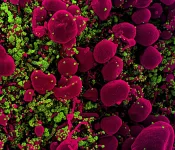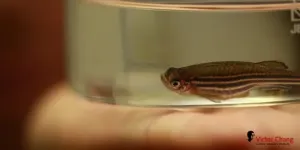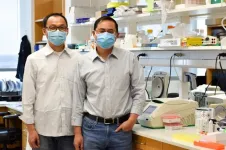Green chemistry and biofuel: the mechanism of a key photoenzyme decrypted
2021-04-08
(Press-News.org) The functioning of the enzyme FAP, useful for producing biofuels and for green chemistry, has been decrypted. This result mobilized an international team of scientists, including many French researchers from the CEA, CNRS, Inserm, École Polytechnique, the universities of Grenoble Alpes, Paris-Saclay and Aix Marseille, as well as the European Synchrotron (ESRF) and synchrotron SOLEIL. The study is published in Science on April 09, 2021.
The researchers decrypted the operating mechanisms of FAP (Fatty Acid Photodecarboxylase), which is naturally present in microscopic algae such as Chlorella. The enzyme had been identified in 2017 as able to use light energy to form hydrocarbons from fatty acids produced by these microalgae. To achieve this new result, research teams used a complete experimental and theoretical toolkit.
Understanding how FAP works is essential because this photoenzyme opens up a new opportunity for sustainable biofuel production from fatty acids naturally produced by living organisms. FAP is also very promising for producing high added-value compounds for fine chemistry, cosmetics and pharmaceutics.
In addition, due to their light-induced reaction, photoenzymes give access to ultrarapid phenomena that occur during enzymatic reactions. FAP therefore offers a unique opportunity to understand in detail a chemical reaction taking place in living organisms.
More specifically, in this work, researchers show that when FAP is illuminated and absorbs a photon, an electron is stripped in 300 picoseconds from the fatty acid produced by the algae. This fatty acid is then dissociated into a hydrocarbon precursor and carbon dioxide (CO2). Most of the CO2 generated is then turned in 100 nanoseconds into bicarbonate (HCO3-) within the enzyme. This activity uses light but does not prevent photosynthesis: the flavin molecule within the FAP, which absorbs the photon, is bent. This conformation shifts the molecule's absorption spectrum towards the red, so that it uses photons not used for the microalgae's photosynthetic activity.
It is the combined interpretation of the results of various experimental and theoretical approaches by the international consortium that yields the detailed, atomic-scale picture of FAP at work. This multidisciplinary study combined bioengineering work, optical and vibrational spectroscopy, static and kinetic crystallography performed with synchrotrons or an X-ray free electron laser, as well as quantum chemistry calculations.
INFORMATION:
The study involved a strong collaboration of French researchers from the Biosciences and Biotechnologies Institute of Aix-Marseille (CEA/CNRS/Aix-Marseille University), the Institute of Structural Biology (CEA/CNRS/Grenoble Alpes University), the Laboratory for Optics and Biosciences (CNRS/École Polytechnique-Institut Polytechnique de Paris/Inserm), the Advanced Spectroscopy Laboratory for Interactions, Reactivity and the Environment (CNRS/University of Lille), the Institute for Integrative Biology of the Cell (CEA/CNRS/Paris-Saclay University), the SOLEIL synchrotron and also from the European Synchrotron (ESRF) and the Laue Langevin Institute (ILL), two major European instruments based in Grenoble, France. It received funding from the French National Research Agency. The study also involved researchers from the Max Planck Institute in Heidelberg (Germany), Moscow State University (Russia) and the SLAC National Accelerator Laboratory (USA).
[Attachments] See images for this press release:

ELSE PRESS RELEASES FROM THIS DATE:
2021-04-08
Two studies published in the open-access journal PLOS Pathogens provide new evidence supporting an important role for the immune system in shaping the evolution of SARS-CoV-2, the virus that causes COVID-19. These findings--and the novel technology behind them--improve understanding of how new SARS-CoV-2 strains arise, which could help guide treatment and vaccination efforts.
For the first study, Rachel Eguia of Fred Hutchinson Cancer Research Center in Seattle, Washington, and colleagues sought to better understand SARS-CoV-2 by investigating a closely related virus that has circulated widely for a far longer period of time: the common-cold virus ...
2021-04-08
A group led by scientists from the RIKEN Cluster for Pioneering Research, using coordinated observations of the Crab pulsar in a number of frequencies, have discovered that the "giant radio pulses" which it emits include an increase in x-ray emissions in addition to the radio and visible light emissions that had been previously observed. This finding, published in Science, implies that these pulses are hundreds of times more energetic than previously believed and could provide insights into the mysterious phenomenon of "fast radio bursts (FRBs)."
Giant radio pulses--a phenomenon where extremely short, millisecond-duration pulses of radio waves are emitted--have ...
2021-04-08
Researchers at the Francis Crick Institute have found that blocking a specific protein could increase tumour sensitivity to treatment with PARP inhibitors. Their work published in Science , suggests combining treatments could lead to improved therapy for patients with inheritable breast cancers.
Some cancers, including certain breast, ovarian and prostate tumours, are caused by a fault in the BRCA1 or BRCA2 genes, which are important for DNA repair. Treatment for these cancers has greatly improved thanks to the discovery of PARP inhibitors, drugs which capitalise on this weakness in the cancer ...
2021-04-08
Scientists at the Victor Chang Cardiac Research Institute in Sydney have discovered a critical new gene that it is hoped could help human hearts repair damaged heart muscle after a heart attack.
Researchers have identified a genetic switch in zebrafish that turns on cells allowing them to divide and multiply after a heart attack, resulting in the complete regeneration and healing of damaged heart muscle in these fish.
It's already known that zebrafish can heal their own hearts, but how they performed this incredible feat remained unknown, until now. In research recently published in the prestigious journal, Science, the team at the Institute drilled down into a critical ...
2021-04-08
Modern humans are fundamentally different from our closest living relatives, the great apes: We live on the ground, walk on two legs and have much larger brains. The first populations of the genus Homo emerged in Africa about 2.5 million years ago. They already walked upright, but their brains were only about half the size of today's humans. These earliest Homo populations in Africa had primitive ape-like brains - just like their extinct ancestors, the australopithecines. So when and where did the typical human brain evolve?
CT comparisons of skulls reveal modern brain structures
An international ...
2021-04-08
Researchers have developed a new algorithm capable of identifying features of male zebra finch songs that may underlie the distinction between a short phrase sung during courtship, and the same phrase sung in a non-courtship context. Sarah Woolley of McGill University in Montreal, Canada, and colleagues present these findings in the open-access journal PLOS Computational Biology.
Like many animals, male zebra finches adjust their vocal signals for their audience. They may sing the same sequence of syllables during courtship interactions with females as ...
2021-04-08
DALLAS - April 8, 2021 - New research has uncovered a surprising role for so-called "jumping" genes that are a source of genetic mutations responsible for a number of human diseases. In the new study from Children's Medical Center Research Institute at UT Southwestern (CRI), scientists made the unexpected discovery that these DNA sequences, also known as transposons, can protect against certain blood cancers.
These findings, published in Nature Genetics, led scientists to identify a new biomarker that could help predict how patients will respond to cancer therapies and find new therapeutic targets for acute myeloid leukemia (AML), the deadliest type of blood cancer in adults and children.
Transposons ...
2021-04-08
Every third-grader knows that plants absorb nutrients from the soil through their roots. The fact that they also release substances into the soil is probably less well known. And this seems to make the lives of plants a lot easier.
That is at least the conclusion of the current study. The participating researchers studied several maize varieties that differ significantly in their yield. In their search for the cause, they came across an enzyme, flavone synthase 2. "The high-yield inbred line 787 we studied contains large amounts of this enzyme in its roots", explains Dr. Peng Yu ...
2021-04-08
A global science collaboration using data from NASA's Neutron star Interior Composition Explorer (NICER) telescope on the International Space Station has discovered X-ray surges accompanying radio bursts from the pulsar in the Crab Nebula. The finding shows that these bursts, called giant radio pulses, release far more energy than previously suspected.
A pulsar is a type of rapidly spinning neutron star, the crushed, city-sized core of a star that exploded as a supernova. A young, isolated neutron star can spin dozens of times each second, and its whirling magnetic ...
2021-04-08
SALT LAKE CITY - A letter published today by Huntsman Cancer Institute (HCI) at the University of Utah (U of U) in the New England Journal of Medicine reports that melanoma mortality among Utahns outpaced that of the rest of the United States during the period from 1975 to 2013. Melanoma death rates have been decreasing in recent years both in Utah and the United States, a trend likely attributable to new, more effective treatments, like immunotherapy. However, melanoma remains the deadliest type of skin cancer, and the incidence of melanoma diagnoses in Utahns is higher than in any other ...
LAST 30 PRESS RELEASES:
[Press-News.org] Green chemistry and biofuel: the mechanism of a key photoenzyme decrypted







